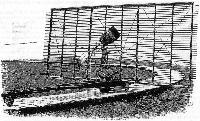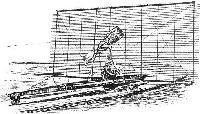A.Andrews. The Flying Machine: Its Evolution through the Ages (Putnam)
In 1875 a serious young English engineer, Horatio Phillips, then only 20 years old, had been experimenting with hydrofoils and took out a patent on them. He turned to aerofoils, and devised a new wind-tunnel to test them, inducing by steam injection a much steadier airflow than Wenham’s fan-generated currents. By 1884 he had registered patents on six double-surface aerofoil sections of varying gradation and camber, intended to shape curved wings for aircraft. Phillips laid down the theory that increased camber on the top of a double-surface wing creates the suction of reduced pressure above, and gives lift. Later he refined the shape of his double-surface aerofoils to flatten the lower part of the leading-edge into a bi-convex shape designed to diminish drag and increase lift. He went on to build both models and full-size aircraft based on his corollary that superimposed aerofoils of his design, constructed with high aspect ratio (ie, long and narrow) would provide admirable lift. From this assertion there came the famous ‘Venetian blind’ - not Phillips’s term, but everybody else’s for his multiplane of 1893, an erection of no less than 40 aerofoils 19ft long and l|in chord, set vertically behind a 6ft 6in tractor propeller in a wheeled frame on a circular track over 100yd round.
This test-rig did rather worse than Hiram Maxim’s, which was being operated about the same time. At 40mph the rear wheel of the tricycle dolly lifted 3ft but the front wheels stayed earthbound. But a similar rig on a 200yd circuit lifted almost 400lb. In 1904, when the light petrol engine was more advanced, Horatio Phillips put a pilot aboard a similar machine, free-running this time, though with only 20 cambered aerofoils. But, although again the lift was good, the balance was wrong and the multiplane had poor longitudinal stability.
Показать полностью
M.Goodall, A.Tagg British Aircraft before the Great War (Schiffer)
Deleted by request of (c)Schiffer Publishing
PHILLIPS helicopters and multi-planes (Horatio Frederick Phillips, Norwood, Harrow, Southminster, Streatham etc.)
Phillips, born 1845, was an inventor who began experimental aeronautical work with models, including making experiments with various forms of propulsion, aiming at a lightweight engine for flight purposes. His particular contribution was his work on aerofoil sections, from which the term 'Phillips Entry' is still used as a description and which were the subject of Patent Nos.13768/1884 and 13311/1891. His experimental equipment included a large steam powered Whirling Arm and a Circular Track as part of his costly experiments.
He aimed initially to develop direct lift types, i.e. helicopters, but lacking success with these, turned to gliders and models. His experience with the use of flexible fabric covering led him to decide to use solid 'sustainers', i.e. aerofoils, and he used examples of these, ranging in chord from 1.5 to 24 inches in the course of his trials. The nature of these narrow sections led to the design of 'Multi-planes' with many individual aerofoils in supporting frames. Several were built before a limited degree of success was achieved. His Patent No.20435/1890 covered machines with two or more frames.
Phillips carried out aeronautical experiments from about 1864 until 1910. Some of his early work was facilitated by his position as works manager, from 1890 to 1902, of the factory at Harrow of gun makers Cogswell and Harrison Ltd. This position, and their mutual interests, brought him into contact with Hiram Maxim. Support was also provided in 1893-1894 by the Comte de Lambert, but this was withdrawn owing to problems arising as a result of Phillips drinking habits. After retirement from business in 1902, Phillips devoted his time to experimental aeronautics and later to work as a motor and general mechanical engineer, with premises at West Barnham, Sussex. He died in 1926.
PHILLIPS helicopters and monoplane
In about 1870, a direct lift machine was constructed at Battersea, south London, in one of the railway arches. This was powered by a steam engine, of Phillips' own design, and drove contrarotating steel rotors, later replaced by 20ft diameter wooden rotors. No success was achieved during tests in Battersea Fields. In 1903, with his son A.H. Phillips, he was again testing direct lift machines at the Crystal Palace, but again without success. One of these had 33ft diameter contra-rotating rotors driven by a 15 hp petrol engine.
At this time Phillips also built a petrol engined monoplane on floats, which was launched on the Thames from Messengers Island, Surbiton with his son in control. The first trial was stopped when the port wing lifted 56ft and the machine, banking steeply, was at risk as it rounded the bend in the river towards Hampton Court. The trials were discontinued after the propeller broke and were not resumed.
In 1904, at Furzle Down Farm, Mitcham a machine with a more powerful motor driving two 20ft diameter rotors, set at nine degrees from the vertical, on the ends of a girder, was also tried. The tilt was to create some forward motion to aid takeoff, but as with previous machines, this was a complete failure. Phillips returned to direct lift machines in the autumn of 1909, when a new machine gave promising results and encouraged him to again pursue the principle, which he regarded as the practical flying machine of the future, particularly in England with its small fields and open spaces.
PHILLIPS multi-planes
Phillips pursued his aeronautical work with models after his early disappointments with rotary wings. Using models weighing up to 20 lb., which were shot from a catapult, he then constructed at Norwood a circular concrete track of 500ft circumference, 160ft diameter approximately, and tethered his machine to the center. First he used a full size type of box-kite with fabric covering, but soon decided on the use of more rigid aerofoils. This work led to the patents of 1884 and 1891 and the favoring of solid narrow aerofoils and the multi-plane type aircraft. To assess the best form for the blades, he proposed to use a steam driven whirling arm machine traversing a circumference of 323ft, 103ft diameter, to test them.
PHILLIPS multi-plane No.l 1893
Resulting from the work on the whirling arm and other tests, Phillips constructed a large unmanned multi-plane, with fifty aerofoils in a frame, mounted on a body on three wheels, with the single wheel at the front and was propelled by a compound steam engine driving a two-bladed tractor propeller. Phillips was sponsored by the Comte de Lambert at this time, which resulted in this engine being sold by the Count to the Musee de 1'Air in 1936.
The machine was tested on a circular track at Harrow, 628ft. in circumference, 200ft diameter, anchored to a central post, where it lifted itself and a 56 lb. load, a total of 416 lb., about 2ft in 1893.
Power: 6hp Phillips compound steam engine driving a two-bladed tractor propeller
Data
Span 22ft
Chord of slats 1 1/2 in
Area 136 sq. ft
Length 20ft
Height 9ft 6in
Weight 360 lb.
Показать полностью
Журнал Flight
Flight, July 5, 1913.
THE PIONEERS.
<...>
Another interesting series of experiments was carried out about the same date at Harrow, on a circular track, by Phillips. The machine in question had numerous very thin cambered planes arranged somewhat in the appearance of a Venetian blind. Phillips' name, however, is more generally associated with his experiments on cambered sections, and in particular with a peculiar form of section having a pronounced hump over the front edge, which is sometimes referred to as the "Phillips entry."
<...>
Показать полностью





